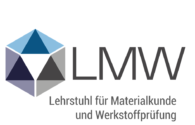Research
Materials for additive manufacturing
The research area of additive manufacturing is being newly established at the Chair of Materials Science and Materials Testing (LMW) and will complement the existing research fields of materials analysis and materials testing with the disciplines of materials development and materials technologies.
more information
|
Kontakt: Dr.-Ing. Carolin Zinn
|
Hybrid materials
FOR3022 – Ultrasonic Monitoring of Fiber Metal Laminates Using Integrated Sensors Subproject 1 – Effect of state characteristics, in particular residual stresses and damage, on the wave propagation
Characterization and Classification of damage in FML
more information
| According to common scientific knowledge it is not possible to uniquely determine the cause of a change in wave propagation in Fiber Metal Laminates (FML), if various environmental conditions and a changing interlaminar stresses affect the Guided Ultrasonic Waves (GUW) Structural Health Monitoring (SHM) system at the same time. Therefore, the effects of separate relevant state characteristics are studied systematically in this subproject under FOR 3022 to develop appropriate compensation methods and hence make reliable damage detection possible. Experimental methods are used to gain a correlation between wave propagation and damage, as well as to determine the influence of thermal effects or interlaminar pre-stresses in particular those induced by process related residual stress during manufacturing. This residual stress describes an internal stress state caused by different thermal expansion coefficients in a FML, resulting in a pre-stress of the individual layers. Glass Laminate Aluminium Reinforced Epoxy (GLARE) and Carbon Fibre Reinforced Polymer (CFRP) steel laminates are investigated. With regard to the differences of stiffness and thermal properties, these two FMLs represent extreme cases in the behaviour considered. Supporting detection methods based on X-ray and computed tomography (CT) or ultrasonic testing (UT) with bulk waves are used at University of Siegen in participation with University of Bremen, TU Braunschweig to obtain a clear relationship between wave propagation, residual stresses and damage characteristics. The specific damage characteristics are used in the other subproject to validate the simulation model and are further incorporated in the machine learning methods developed. The aim of the conducted investigations is a profound understanding of how different conditions and impact damage affect the propagation of GUW in FML. Fig. 1 illustrates this approach. 
Project partners:  
Contect: M.Sc. Chirag Shah
|
Material fatigue
Consideration of the impact of residual stress in a martensitic steel for the modification of micro-structure-based fracture mechanics
more information
| In contrast to the phases of crack initiation and long crack propagation the short crack propagation in martensitic spring steels is largely unresearched. This means that the technical cracking phase, which can account for up to 90% of the fatigue life in the high cycle fatigue regime, is not fully understood. Furthermore, there is no knowledge of the impact of residual stress on this phase of fatigue damage. This project targets on a characterization of the mechanisms of fatigue in martensitic spring steels by the propagation of short cracks taking into account the impact of residual stress. Furthermore, a materials science based simulation of the propagation of short cracks should be elaborated by means of a model which is based on the experimentally observed mechanisms. Thus, a better understanding of the metal physical processes in martensitic steels under cyclic loading in the HCF regime is established. 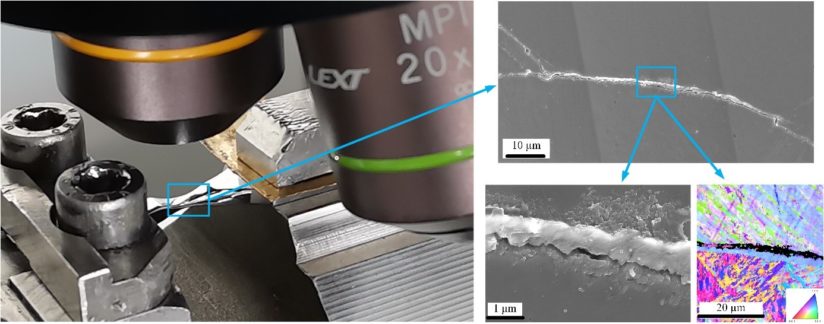
Project partners: 
Contect: M.Sc. Anna Wildeis
|
Investigation of fatigue damage evolution in polycrystalline materials by µLaue diffraction using a 3D energy dispersive detector
more information
The development of fatigue damage in metallic materials in the preliminary state before a crack is present is usually determined using time-consuming and mostly destructive methods. However, a characterization of the present microstructure with regard to dislocation arrangements would support a prediction of the remaining lifetime. In the project presented here, an approach is therefore being pursued which can determine the microstructural changes non-destructively within a very short time using Laue diffraction. For this purpose, white X-ray light and an energy-dispersive detector are used, which enables a locally and energy-resolved measurement. The broadening of the observed X-ray reflections correlates directly with the dislocation density of the material and thus also with the existing fatigue exposure. 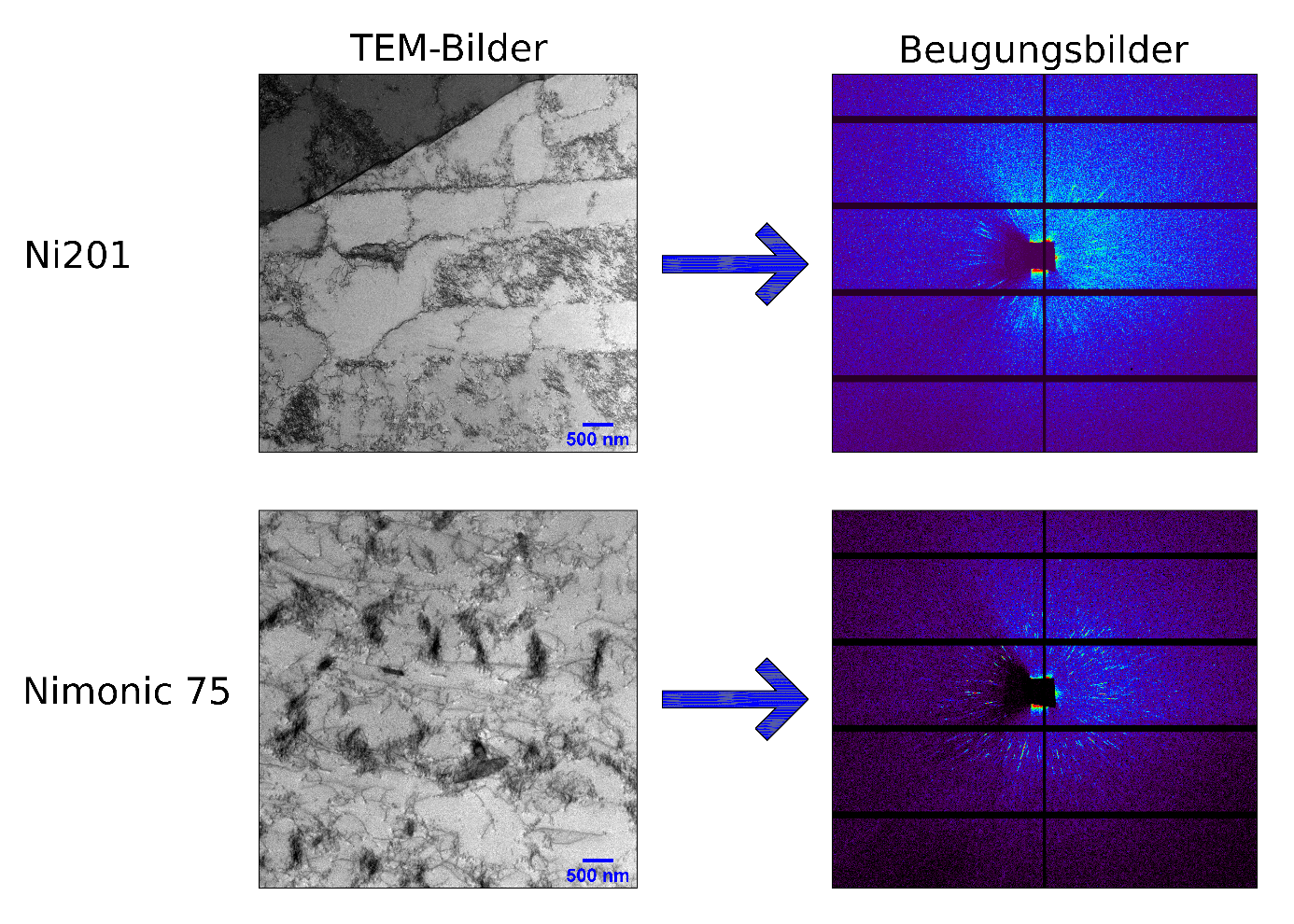
Project partners: 
Contect: M.Sc. Carolin Leidigkeit
|
Very high cycle fatigue (VHCF) behavior in type 304 austentic stainless steel
more information
It is well-known that the failure mechanisms under HCF and VHCF are entirely different. HCF is dominated by PSB-induced crack nucleation from the surface. VHCF behavior is strictly governed by the material condition. Single phase (fcc) ductile materials are classified as Type-I where crack initiates mainly from the surface due to surface roughening induced by irreversible random slip. This occurs when the macroscopic stress is well below the classical fatigue limit where the crack initiation through formation of persistent slip band or PSB (strain localization) is not possible. On the other hand, subsurface crack initiation is mainly governed by the presence of non-metallic inclusions in the material, classified as Type-II (mostly high strength steels). Alexander von Humboldstiftung 
Contect: Dr. Aritra Sarkar
|
Low cycle fatigue and creep- fatigue interaction studies in the bimodal gamma prime (γ’) strengthened nickel – based superalloy 718plus
more information
Alloy 718Plus provides not only optimum properties at room & high temperature, but also a combination of good formability and weldability, serving as a potential replacement to commercial superalloys for turbine disc applications. Performance of 718Plus, even though comparable to commercial alloys at elevated temperatures, fails drastically with the application of dwell times. Numerous attempts have been made to improve the performance, but systematic study on the role of size of strengthening precipitates, their size distribution and their effect on the damage mechanisms are still lacking. Synergistic effects from grain boundary precipitates (δ) and environmental interactions have always been present so far. Modification of size, volume fraction and distribution of γ’ precipitate may improve the LCF and CFI behaviour. To know the effect of modified microstructure on crack propagation, the samples will also be subjected to crack propagation tests under different environmental for synergistic effects. To understand the effects of modified microstructure on LCF life of material, the delta precipitation at grain boundaries must be avoided. The prime objective of this proposal is to identify the effects of low cycle fatigue and creep-fatigue interaction on life of alloy with modified microstructure and understand the damage mechanisms involved. This might provide new insights to modify the alloy further, for better and efficient performance. Standard samples of 718Plus will also undergo the same test schedule to establish a comparative data pool. Transmission Electron Microscopy is be used to better understand the dislocation interactions and substructure formation at test conditions and provide structure-property correlations to predict the material’s behaviour in varied service situations. Project partners: 
Contect: Barun Bharadwaj Dash
|
IInnovative high-temperature materials
Development of refractory metal-based alloys with improved mechanical properties
more information
Refractory high entropy alloys (RHEA) are considered to be promising candidates for high temperature. RHEAs consist of five or more principal elements in near equiatomic concentrations. The alloy Ta-Mo-Cr-Ti-Al possesses a multiphase microstructure consisting of an ordered B2 matrix as well as an intermetallic Laves phase. The project will focus on the development of alloys based on the system Ta-Mo-Cr-Ti-Al with A2 matrix and large volume fractions of ordered B2 precipitates to achieve balanced properties of ductility at room temperature, creep resistance at elevated temperatures, and oxidation protection. In order to fulfill these objectives, alloy engineering measures are planned to suppress the formation of brittle intermetallic phases and simultaneously increase the intrinsic ductility of the matrix. Alloy development is based on thermodynamic calculations as well as experimental analytical methods. 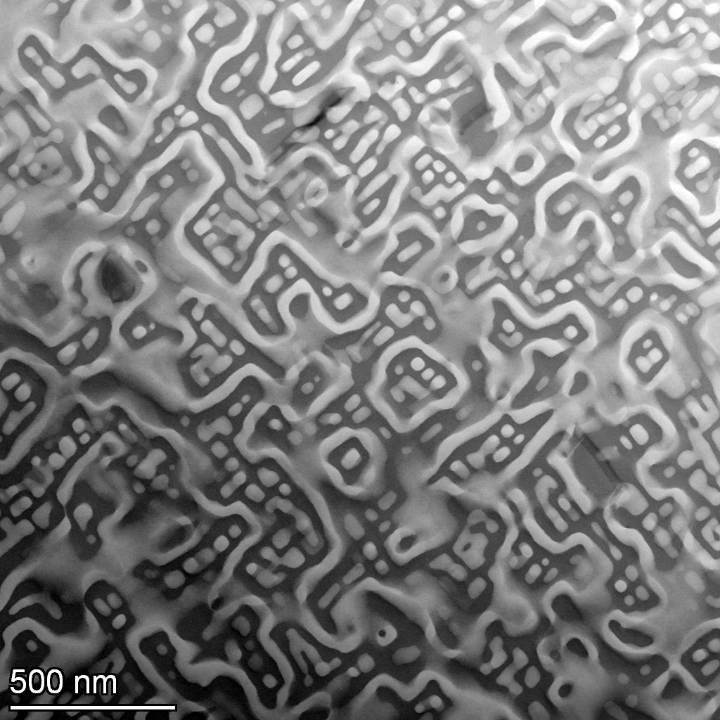
Project partner: 
Founding: Deutsche Forschungsgemeinschaft Contect: M.Sc. Stven Schellert
|
Integrative design of novel Mo-Si-alloys and protective coatings for high temperature applications
more information
| In order to increase the efficiency of gas turbines in the future, new high-temperature materials with improved temperature potential and lower specific weight are required. Mo-Si-B alloys, which have good high-temperature properties, offer high potential in this field of application. 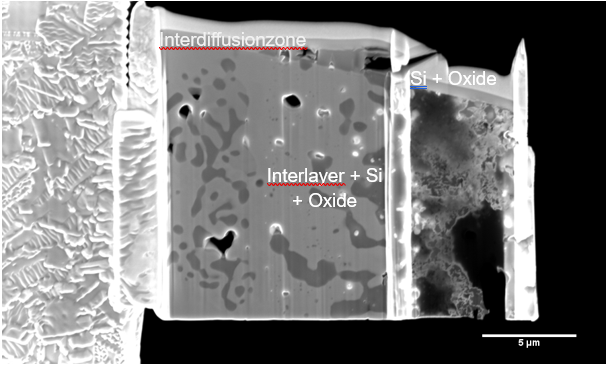
Project partner: 
Contect: M.Sc. Matthias Weber
|
Development and characterization of eutectic V-Si-B alloys with improved specific mechanical properties for high-temperature applications
more information
High-temperature materials are essential in the development of aircraft gas turbines. The selected materials must be able to resist high mechanical and corrosive stresses at temperatures above 1000°C. Due to increasing requirements, refractory metal-based alloys are increasingly coming into focus. The element Vanadium could offer a lucrative and interesting alternative to the materials used so far. As part of the project, a comprehensive understanding of the vanadium-silicon-boron system is to be gained. This includes phase formation and transformation during solidification, as well as phase stability and transformation at equilibrium state. For this purpose, a thermodynamic database was created, which is constantly optimized and adapted to the obtained results from different alloys. 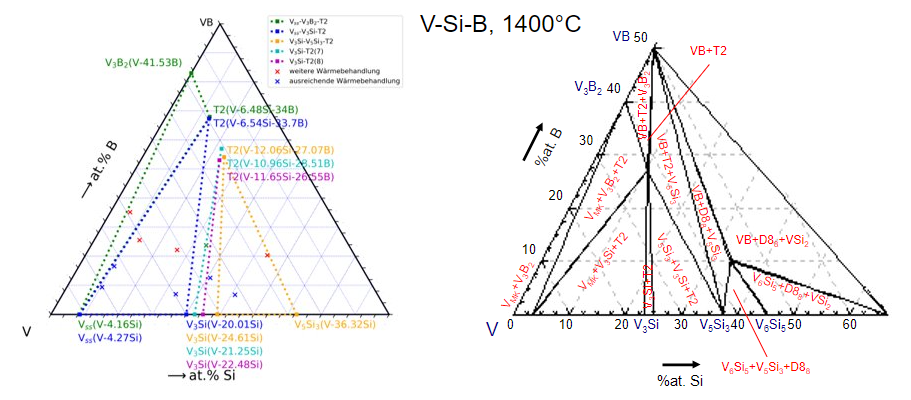
Project partner: 
Contect: M.Sc. Mustafa Yazlak
|
Materials in hydrogen environment
Hydrogen as a temporary alloying element for the adjustment of specific microstructural gradients in the (alpha+beta)-titanium alloy Ti 6Al-4V
more information
Technical components are subject to growing demands in terms of durability and reliability. Besides, they should be produced and designed sustainably. To meet these expectations, the development of thermochemical processes is auspicious. Titanium alloys, which have a comparatively high gas solubility, allow temporary hydrogen loading, often called thermohydrogen treatment (THT). THT causes lattice deformation and reduces the β-transformation temperature. This research project intends to realize a local microstructure adaptation depending on the distance to the surface (microstructural gradient) via THT, which should improve the fatigue properties compared to conventionally produced titanium alloy microstructures. 
Founding: 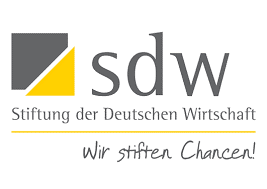
Contect: M.Sc. Christopher Schmidt
|
Aktualisiert um 14:07 am 22. October 2021 von gk408



